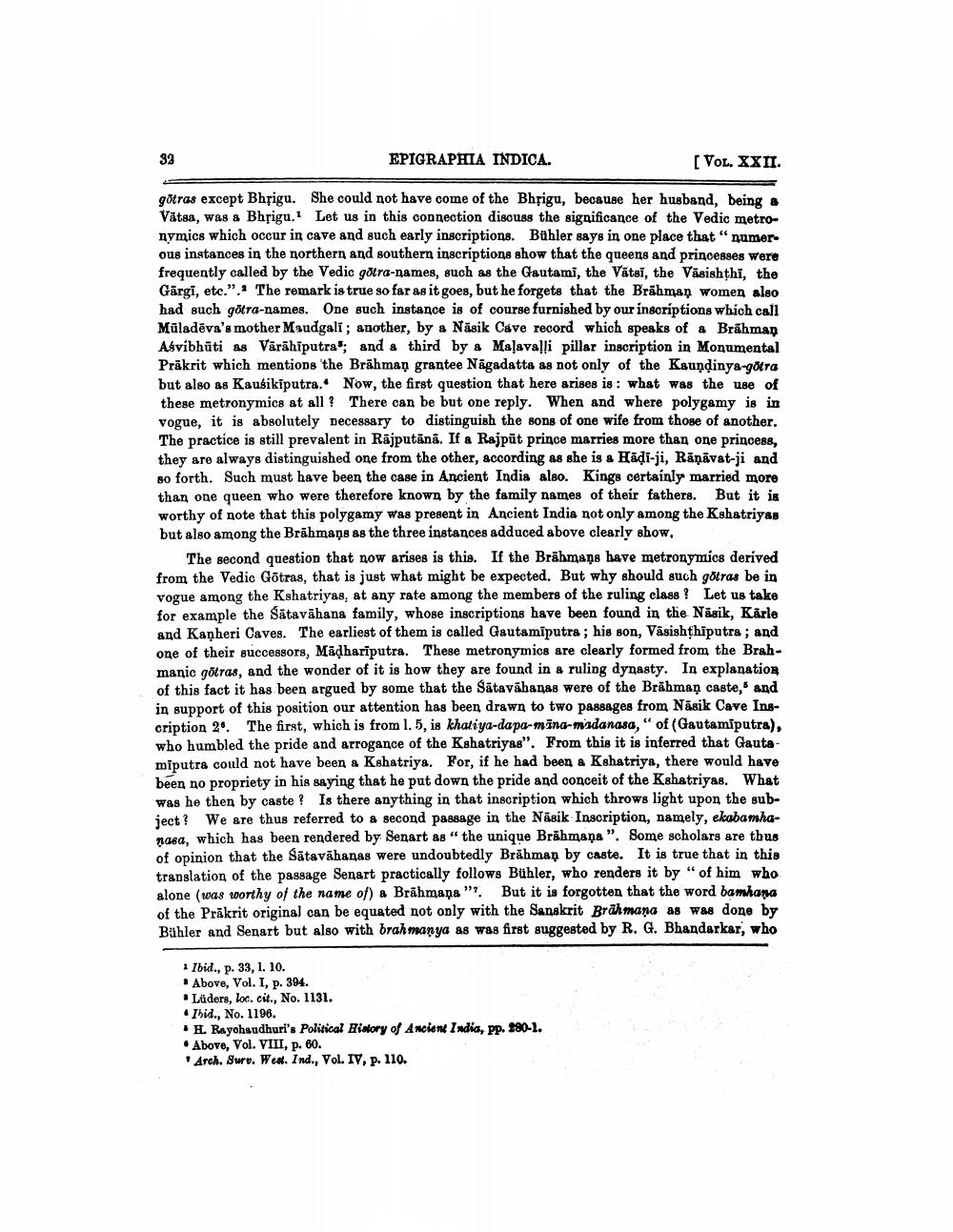________________
32
EPIGRAPHIA INDICA.
[VOL. XXII.
gotras except Bhrigu. She could not have come of the Bhrigu, because her husband, being a Vatsa, was a Bhsigu. Let us in this connection discuss the significance of the Vedic metronymics which occur in cave and such early inscriptions. Bühler says in one place that "numerous instances in the northern and southern inscriptions show that the queens and princesses were frequently called by the Vedic götra-names, such as the Gautami, the Vātsi, the Vásishthi, the Gārgi, etc.". The remark is true so far as it goes, but he forgets that the Brāhman women also had such götra-names. One such instance is of course furnished by our inscriptions which call Mūladēva's mother Maudgali; another, by a Nāsik Cave record which speaks of a Brahman Asvibhūti as Värähiputra"; and a third by & Maļavalli pillar inscription in Monumental Prākrit which mentions the Brāhmaṇ grantee Nāgadatta as not only of the Kauņdinya-gotra but also as Kausikiputra. Now, the first question that here arises is: what was the use of these metronymics at all? There can be but one reply. When and where polygamy is in vogue, it is absolutely necessary to distinguish the sons of one wife from those of another. The practice is still prevalent in Rājputānā. If a Rajpūt prince marries more than one princess, they are always distinguished one from the other, according as she is a Hādi-ji, Rāņāvat-ji and so forth. Such must have been the case in Ancient India also. Kings certainly married more than one queen who were therefore known by the family names of their fathers. But it is worthy of note that this polygamy was present in Ancient India not only among the Kshatriyas but also among the Brāhmaṇg as the three instances adduced above clearly show,
The second question that now arises is this. If the Brāhmans have metronymics derived from the Vedic Götras, that is just what might be expected. But why should such gotras be in vogue among the Kshatriyas, at any rate among the members of the ruling class ? Let us take for example the Sātavāhana family, whose inscriptions have been found in the Näsik, Kärle and Kaņheri Caves. The earliest of them is called Gautamiputra; his son, Väsishthiputra; and one of their successors, Mādhariputra. These metronymics are clearly formed from the Brahmanic götras, and the wonder of it is how they are found in a ruling dynasty. In explanation of this fact it has been argued by some that the Sātavāhanas were of the Brāhman caste,' and in support of this position our attention has been drawn to two passages from Näsik Cave Ingcription 2. The first, which is from 1.5, is khatiya-dapa-mina-madanasa," of (Gautamiputra), who humbled the pride and arrogance of the Kshatriyas". From this it is inferred that Gautamiputra could not have been a Kshatriya. For, if he had been a Kshatriya, there would have been no propriety in his saying that he put down the pride and conceit of the Kshatriyas. What was he then by caste? Is there anything in that inscription which throws light upon the subject? We are thus referred to a second passage in the Násik Inscription, namely, ekabamhanaea, which has been rendered by Senart as "the unique Brāhmaṇa". Some scholars are thus of opinion that the Sātavāhanas were undoubtedly Brāhman by caste. It is true that in this translation of the passage Senart practically follows Bühler, who renders it by " of him who alone (was worthy of the name of) a Brāhmaṇa"? But it is forgotten that the word bamhana of the Prākrit original can be equated not only with the Sanskrit Brāhmana as was done by Bühler and Senart but also with brahmanya as was first suggested by R. G. Bhandarkar, who
1 Ibid., p. 33, 1. 10. . Above, Vol. I, p. 394. • Lüders, loc. cit., No. 1131. • Thid., No. 1196.
H. Rayohaudhuri's Political History of Ancient India, pp. 280-2. . Above, Vol. VIII, p. 60.
Arch. Surv. West. Ind., Vol. IV, p. 110.
W




